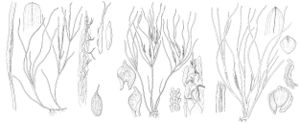Zostera
Sp. Pl. 2: 968. 1753; Gen. Pl. ed. 5; 415, 1754.
| Taxon | Illustrator ⠉ | |
|---|---|---|
 | Phyllospadix scouleri Zostera marina Phyllospadix torreyi | John Myers John Myers John Myers |
Herbs, perennial or rarely annual, rooted in substrate. Roots 5–20, nodal. Leaves: sheath tubular or open, persisting longer than blade, often rupturing with age but not remaining as bundles of woolly fibers; blade entire or slightly denticulate distally; veins 3–11. Generative shoot lateral or terminal. Inflorescences: peduncle partially adnate to stem; spadix lanceolate, enclosed permanently within spathe sheath; staminate and pistillate flowers alternating on same spadix; pistillate spadix without rudimentary staminate flowers. Staminate flowers often subtended by bract. Pistillate flowers without subtending bract, pistil elliptic. Fruits achenelike, ovoid to ellipsoid.
Distribution
Temperate waters worldwide
Discussion
Zostera, especially Z. marina, is very possibly the most important taxon of marine angiosperms in the Northern Hemisphere. Much has been written about the biology and economic importance of Z. marina, and the literature was summarized by C. den Hartog (1970). The species functions in sediment deposition, substrate stabilization, as substrate for epiphytic algae and micro-invertebrates, and as nursery grounds for many species of economically important marine vertebrates and macro-invertebrates. In addition to those functions, the species once was the principal material for the Dutch dikes, and it has been utilized as packing material and as stuffing for mattresses and cushions. Finally, the species has been used for food and recreation by the Seri tribe of Native Americans (R. Felger and M. B. Moser 1973).
During the 1930s, Zostera marina of North America began to develop large brown spots on the leaves and rhizomes. Slowly the plants of a population died, the dieback eventually spreading throughout the North Atlantic, until there was very little eel-grass remaining there. This slow dieback of eel-grass became known as "wasting disease." Biologists began studying the disease and eventually determined the causative agent to be Labyrinthula zosterae, a slime mold. That dieback resulted in huge decreases in the population sizes of most fauna that depended on Zostera. Slowly, eel-grass returned to most areas that it had occupied prior to the disease.
Species 12 (2 in the flora).
Selected References
Lower Taxa
Key
| 1 | Leaf sheath tubular, without membranous flaps, rupturing with age; bract absent or rarely 1 subtending lowermost staminate flower. | Zostera marina |
| 1 | Leaf sheath open, with 2 membranous flaps, persisting without rupturing; bract subtending each staminate flower. | Zostera japonica |
"not elongating" is not a number.